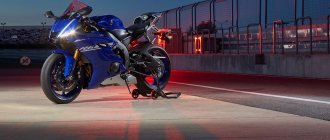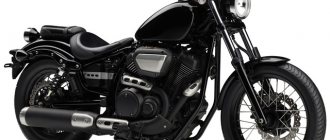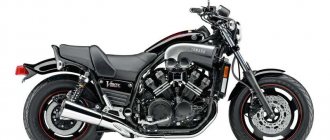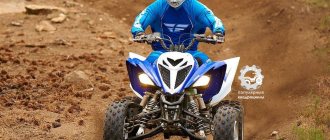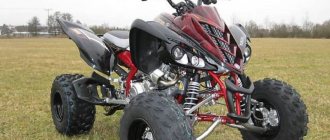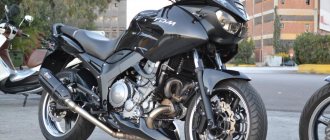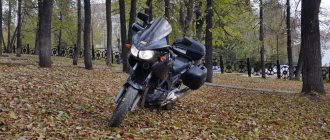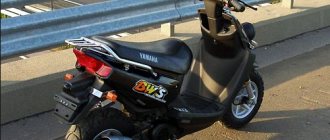The main goal of a first-season motorcyclist is to survive. Neither a powerful chopper, nor fast sports, nor driving skills in the Urals in your grandfather’s village will help you master driving techniques in a metropolis. Learn to change lanes in traffic, fit between rows, maneuver freely and calculate the road situation - for this, a beginner does not need a fast car or a chrome-plated beauty. The purpose of the first motorcycle is to teach and give joy. The joy of owning an iron horse, the headwind in your face and the endless horizon of roads that open up for you.
No one knows for sure how many thousands of newcomers the Yamaha YBR 125 has “trained” and successfully released into the motorcycle world over the course of more than ten years. Affordable price, ease of operation, ideal weight and dimensions make the Ebrik the undisputed market leader among educational and small-capacity motorcycles.
Advantages and disadvantages of Yamaha YBR 125
What allows a Chinese-assembled dairy road builder to remain stable on the Russian market for more than a decade?
The Yamaha YBR125 motorcycle has been produced from 2004 to the present, and is deservedly positioned as an inexpensive motorcycle for study, or as a light road bike for beginners. Let's take a look at the insides of the ebrik:
- Engine capacity – 125 cc;
- Number of cylinders – 1;
- Four-stroke engine;
- The gearbox is 5-speed;
- Drive system – chain;
- Length – 1980;
- The front tire size of Yamaha YBR125 motorcycles is 2.75-18 42P, and the rear tire size is 90/90-18 M/C 57P;
- It weighs 122-125 kg. depends on the model;
- Minimal body kit.
Everything is kept as compact as possible for its class: electronic and kick starter, air-cooled engine with a capacity of 10 horsepower. It will not look for surprises in the design and chassis - a diagonal frame made of steel, a telescopic front fork, with double shock absorber. The brakes are classic: front disc, hydraulic, and rear drum.
As a result of 4 generations, the result was an ideal device: reliable in operation, unpretentious in maintenance and repair, economical in consumption, maneuverable and easy to operate. Add the cost, which corresponds to the quality, and you will understand why demand does not fall, and the Yamaha YBR 125 technical specifications that we cited above remain on the assembly line for so many years. The Japanese concern's focus on simplicity has paid off.
It took me three days to write a review about the Yamaha YBR125 model, after three seasons.
Yamaha YBR125 motorcycle. The quieter you go, the further you'll get
YBR125, although produced in China, is controlled by a Japanese concern. Like all “Japanese” cars, it is designed for driving, not for repairs. And the use of our roads could not “kill” the Yamaha during my test drive. I will give the opinions of other users at the end of my story, in the “Yamaha YBR 125 reviews” section.
So, in order. In the fall, the Honda Steed 400 was finally disassembled and sold for parts, but I didn’t want to miss the season at all. Sports and endurikes did not attract me, and the most similar to the classic and cheapest in price was the Yamaha YBR 125, the features of which forced me to consider it in more detail. The semi-fairing and the dashboard with two glasses give the motorcycle the very desired appearance. The seating position turned out to be surprisingly comfortable, and the first hours on the road confirmed that I had made the right choice.
At home, the first thing I had to do was adjust the idle speed. With factory carburetor settings, a Yamaha YBR125, produced in 2006, is only suitable for the first lesson in a driving school. Acceleration at the start is positive, and maneuverability in between rows confirms the title of “Traffic Killer”; even on a scooter there is no such efficiency when passing through traffic jams.
The motorcycle moves through potholes softly and impressively, as if not noticing them on the road, the suspension behaves smoothly, but this is up to 60 km/h. Shock absorbers, in general, work 70% percent. A couple of days later, after the first evening trip, I had to disassemble the fairing and adjust the headlight myself. A little later, I replaced the standard headlight with a lensed one.
When on the highway you want to turn the throttle all the way, you immediately stumble over short gears and the number 100 on the speedometer. Yobrik, as it were, accustoms you to a calm driving regime, hinting that you will never be late for your wake. These are the technical characteristics of the Yamaha YBR125 motorcycle.
How much does he eat? how long does it take?
The first gear holds up to 30 km/h without loss, the gear pitch is small: from 10 to 20 km. To achieve maximum speed you have to work hard. An experienced biker is annoyed by short gears. For the Yamaha Ybr 125, the maximum speed on a straight line is 110, you can’t squeeze more out of it. Although for him it’s fast. Fairy tales about acceleration to 120 km/h are just fairy tales. But the 125 turns into corners no worse than a “sport” and holds the road perfectly.
I’ll say right away that during the season, the equipment was not noticed with excessive oil consumption. In terms of average fuel consumption on the Yamaha YBR125, the reviews are almost the same, with a small dramatic difference. Outside the city I often lack power; I squeeze everything I can out of the engine. But more than 4 liters per hundred, at speeds above 8000, with such aggressive driving, the consumption did not rise. My usual consumption is 2.8 liters per 100 km. I am pleased with the omnivorous nature of the engine - my experiments with fuel from 92 to 98 over the course of the season had no effect on the engine’s performance. The mileage has already exceeded 30 thousand, but the consumption remains the same.
Motorcycle design and dynamics
The UBR 125 model is one of those motorcycles that attracts attention.
The pleasant design is combined with a convenient control panel , well-placed levers and pedals.
Statistics and reviews indicate a large number of satisfied customers.
The only generally accepted disadvantage is the narrow body and wheels, which does not so much affect the balance as the comfortable position of the rider.
The almost legendary Ural Solo motorcycles have reached us from the times of the Soviet Union almost without significant changes.
It was decided to transform the Voskhod motorcycle, popular in the USSR, into a new model that could compete with foreign motorcycles.
The dynamics have characteristic features: the motorcycle has difficulty picking up speed. If we talk about normal speeds for the highway (60-80 km/h), then you can feel how vehicles are reluctant to overtake.
Considering the slight retardation of the “iron horse”, do not forget to give way and press in time. Without this, driving can be very dangerous.
Otherwise, the Yamaha behaves excellently on city roads .
The steering radius is very wide, which helps get out of traffic jams and makes it easier to maneuver.
Off-road, the Yamaha behaves ambiguously : in some places it allows you to quickly and easily overcome obstacles, but in other places the model’s power is severely lacking.
This model is not recommended for trips into the forest with a passenger. This may result in problems with the rear shock absorbers.
And there will be a hole in the old woman
Yamaha YBR-125 review of identified jambs. Let's start with the tires: the standard “Sakura” on models up to the third version left much to be desired. During emergency braking, both wheels drag. The contact area with the road is very small. Therefore, the tires were changed to Michelin a week later. The ebrik holds the road much more confidently, both asphalt and dirt road. Simply great! By the way, since 2008, the motorcycle began to be equipped with five-spoke wheels and tubeless tubes.
It's better not to fall on the Yamaha YBR125. The first fall cost me three thousand rubles. The plastic shattered into pieces. Too fragile and unreliable, like the included tool. Screwdrivers break on first contact. It’s better to immediately assemble your own reliable kit.
The standard brake, in my opinion, deserves only a solid “3”. Emergency braking is possible, but only with experience, and only if you're lucky. Within a month, I replaced the flimsy original one with a reinforced brake hose.
The gearbox lug must be taken care of and tightened constantly. Otherwise it will get lost. From the second generation of ebricks, the problem was eliminated by changing the location of the paw. I had to tighten it every week until I had it redone over the winter. The box itself works flawlessly, and, in general, there are no particular complaints about the transmission. Only the chain constantly stretches and asks for replacement after 7,000 kilometers. In models since 2008, an oil seal chain appeared, its resource is indicated up to 18,000 km.
Autumn came, the Yamaha YBR125 carburetor began to act up. As the temperature dropped it was difficult to start. The closer it got to the cold, the more problems became. The Japanese solved this problem, and in the third generation, since 2008, the ebrik received a new heated Mikuni VM22 carb, front fork, brake discs, calipers, and pads.
Weak points, of course, were also found in the chassis. The front fork of the motorcycle breaks in places, causing the motorcycle to peck and dangle along the road. On the advice of experienced comrades, I filled the shock absorber with 15W oil and installed two additional valve springs from the VAZ engine. Now, from pit to pit, the shock absorber manages to decompress and adequately accepts the load even with the second number. I will give a table by year of production of 125s, it may be useful.
- 2004 – 2006 - first;
- 2007–2009 – second;
- 2009 – 2010 - third;
- 2010 – to date – fourth.
Tuning and modifications of Yamaha YBR125
Tuning Yamaha YBR125 is like a drug. The availability of inexpensive spare parts and accessories makes modifications affordable, financially, and very fun. To begin with, I threw out the standard trunk, which had the inscription “no more than 3 kg” on it. My backpack with a tent, sleeping bag and fuel weighs 15 kilograms, and I was not at all happy about losing it on the road. I ordered a new, reinforced tourist trunk with a chrome frame from Ali.
In the nostalgia for the chopper, Steed's fringed leather side cases also found their place. Tuned mirrors of increased size and chrome handles look like original ones. Next season, I plan to change the rear Izhevsk shock absorbers to Honda ones from the SV400. Relatives were taken in the fall, when my friend and I were preparing for our first long-distance trip on the Ebr. The owners' fantasies are amazing. Some people install additional cooling, others use a pendulum on rolling bearings, I’ve also seen YBR-enduro on super “evil” tires.
Yamaha YBR 125 reviews:
I have chosen several reviews that most fully reveal the opinion of the large army of 125 fans especially for you.
“My motorcycle had a problem with carburetors after winter, I bought a tank flushing additive, filled it in, and after 100-150 km, engine performance improved and the problems disappeared. I go, I don’t complain.” (Alexey, Novosibirsk)
“My friend’s father uses a ebrik for fishing trips. He's been driving without any breakdowns for about two years now, and he likes the handling. I only changed the multi-disc clutch and installed tubeless tires.” (Ivan, Moscow)
“Produced in May 2008, the speedometer showed 1020 km. Consumes little gasoline. The two of us drove 90-100 km/h, the consumption turned out to be 2.7 l/100 km. I'm not happy with the tires, but I won't change them for now. For a 35 W light bulb, the light is quite normal and acceptable. The rear shock absorbers are in the 2nd position, but sometimes they can’t handle the passenger, unfortunately.” (Vladimir, Kiev)
“I recommend purchasing. The overall rating of the motorcycle is 4+. He earns his money honestly. The device is simple and reliable. I'm not going to sell. But I’ll install protective roll bars and update the running boards with sensors.” (Mikhail, Kemerovo)
“I’ve been riding for two seasons after getting my license at a motorcycle school. An ideal bike for learning and suitable for almost any beginner. My friend, Nikolai from Krasnodar, generally rode a ebrik comfortably in Africa.” (Olga, Krasnodar)
“This UBR is an excellent device. With moderate maintenance it will last a long time. Really fast for its class: one cylinder is enough for it. I only had problems with the ignition."
Model features
The main advantage of this model is that the motorcycle is completely suitable for a beginner .
The Yamaha YBR 125 weighs little, so it has a great advantage on the road.
also allow you to ride without much fear , because physically it cannot accelerate to dangerous speeds.
There is no doubt about its reliability due to the simplicity of the internal systems.
A slight fall or blow will not allow the motorcycle to fail , and a dead battery can encourage a “kick”, which is so valued among the Slavic class.
One of the main advantages of the model is maximum efficiency. A full tank of fuel is enough for 400 km, and the engine requires only 1 liter of oil.
A simple calculation of the funds spent on the YuBR 125 and any other similar model will confirm this fact. The common people say that Yamaha does not consume gasoline like others, but sniffs it.
Fourth generation. It's getting steeper and steeper...
Due to strange circumstances, the new model, the 4th generation Yamaha YBR125, is not for sale in Russia. You can only buy a Euro, produced from 2010 to 2021, with mileage, from Japan or Europe. This problem does not stop 125 fans. The price for a 2021 motorcycle without mileage in the Russian Federation is approximately 150,000.00 rubles. Not that much money for a dream.
I was lucky to drive a 2013 125 a couple of times, which my neighbor brought from Japan this spring. Having admired the Yamaha YBR 125 photo enough, studied the innovations on the forums far and wide, I got on the motorcycle with a little excitement.
Of course, it differs from previous models, primarily in its more cheerful design and more ergonomic and durable plastic. On the subject of Yamaha YBR125 technical specifications, number 4, which ignite everyone's curiosity:
- an injector has appeared, making starting easier at any temperature,
- added gear engaged indicator,
- a choke button was placed on the steering wheel,
- added a glove compartment under the seat
- the leading star has undergone changes,
- the brakes and the appearance of the rear turn signals have been improved,
- the front brake became two-piston.
Photo gallery
The Japanese two-wheeled stallion Yamaha YBR 125 is a small-capacity, compact, but quite powerful and dynamic motorcycle for its class. Discreet appearance, nothing superfluous, everything is simple and concise. But there is something to see here too.
Kind of like a finale
Yamaha engineers meticulously perfect the 125. And, as we know, there is no limit to perfection. If it weren’t for my love for big, chrome-plated monsters, I would, of course, buy the fourth model. I won’t sell my little one, there is a place for it in my garage, and I have time to take it for a “walk”.
As a first bike, the YBR125 is ideal for some people (riders). For regular trips around the city, a temporary replacement or a “second” motorcycle, there is no need to look for the best option. It simply doesn't exist.
If speed is not your main desire when traveling, if you need nimble, economical and easy-to-repair equipment that still looks decent on the road, then this is your option. A sales leader, as the best budget motorcycle, honestly earning every ruble invested in it, loyal to any tuning, the Yamaha YBR 125 of any generation will become your Friend.
Of course, this is just my personal opinion. Take care of yourself, friends, and good luck on the roads!
Video test drive
Specifications
| Maximum engine power: | 10 HP |
| Torque: | 10 Nm |
| Working volume: | 124 cm3 |
| Motor type (cylinder arrangement, number of strokes): | |
| Number of valves: | |
| Intake type (Injector / Carburetor): | |
| Bore and stroke: | |
| Starting system (Electric starter, kick starter): | |
| Maximum speed in km/h: | 120 km/h |
| Cooling system: | Air |
| Transmission (gearbox): | 5 |
| Clutch (Dry / Wet): | |
| Drive unit: | Chain |
| Frame: | Steel diamond-shaped |
| Chassis | |
| Suspension (front/rear travel): | |
| Brakes (Front/Rear): | |
| Wheels / Tires / Rubber: | |
| Dimensions and weight | |
| Dimensions (Length / Width): | |
| Seat height: | |
| Ground clearance: | |
| Curb weight: | |
| Wheelbase: | 1290 mm |
| Weight: | 125 kg |
| Fuel tank capacity: | 13 l. |
| Battery capacity: | |
| Year of release: | |
| Country of Origin: |
Specifications
| Technical characteristics of Yamaha YBR (Yamaha YuBR) 125 | ||
| Height | m | 1,135 |
| Width | m | 0,745 |
| Ground clearance | m | 0,175 |
| checkpoint | type | Manual transmission, 5-speed; |
| Tank | l | 12 |
| Total curb weight | kg | 122 |
| Maximum speed | km/hour | 140 (actually 115) |
| Maximum load | kg | 200 (actually 198) |
| Drive unit | type | Chain |
| Clutch | type | Multi-disc, which works in an oil bath; |
| Lubrication system | type | Oil sump system |
| Engine | type | One cylinder, 125 cc. cm. |
During production, the Suzuki Intruder 400 motorcycle was produced in two versions - VS and Classic. What are their differences?
The perfection of technical characteristics, as well as the special design of the shiny, streamlined silhouette of this motorcycle, attracts the eye.

